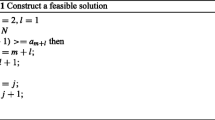Abstract
Suppose that on any day, calls for service are generated by nodes of a transportation network independently with known probabilities. The calls are allocated to p service units that visit the allocated customers on shortest closed tours. That is, each service unit performs an optimal traveling salesman tour on its set of allocated calls (customers). We need to find optimal locations for the service units to minimize the expected travel distance. For this problem on a path, we present an \(O(n^4)\) algorithm, where n is the number of nodes of the network. We also present an \(O(n^5)\) algorithm for the problem on a tree with \(p=2\).
Similar content being viewed by others
References
Ahuja, R., Magnanti, T., & Orlin, J. (1993). Network flows: theory, algorithms, and applications. Upper Saddle River, New Jersey: Prentice-Hall.
Araghi, M., Averbakh, I., & Berman, O. (2014). Minisum multipurpose trip location problems on trees. Networks, 63(2), 154–159.
Averbakh, I., Berman, O., & Simchi-Levi, D. (1994). Probabilistic a priori routing-location problems. Naval Research Logistics, 41, 973–989.
Averbakh, I., & Berman, O. (1995). Probabilistic sales-delivery man and sales-delivery facility location problems on a tree. Transportation Science, 29(2), 184–197.
Berman, O., Jaillet, P., & Simchi-Levi, D. (1995). Location-routing problems with uncertainty. In Z. Drezner (Ed.), Facility location: a survey of applications and methods (pp. 427–452). New York: Springer.
Berman, O., & Simchi-Levi, D. (1986). Minisum location of a travelling salesman. Networks, 16(1986), 239–254.
Berman, O., & Simchi-Levi, D. (1988). Minisum location of a travelling salesman on simple networks. European Journal of Operational Research, 36, 241–250.
Burness, R., & White, J. (1976). The travelling salesman location problem. Transportation Science, 10, 348–360.
Gendreau, M., Jabali, O., & Rei, W. (2016). Future research directions in stochastic vehicle routing. Transportation Science, 50(4), 1163–1173.
Higashikawa, Y., Golin, M., & Katoh, N. (2015). Multiple sink location problems in dynamic path networks. Theoretical Computer Science, 607(1), 2–15.
Hsu, V. N., Lowe, T. J., & Tamir, A. (1997). Structured \(p\)-facility location problems on the line solvable in polynomial time. Operations Research Letters, 21, 159–164.
Lopes, R. B., Ferreira, C., Santos, B. S., & Barreto, S. (2013). A taxonomical analysis, current methods and objectives of location-routing problems. International Transactions in Operational Research, 20, 795–822.
Mosheiov, G. (1995). The pickup delivery location problem on networks. Networks, 26, 243–251.
Nagy, G., & Salhi, S. (2007). Location-routing: issues, models and methods. European Journal of Operational Research, 177, 649–672.
Nguyen, K., & Anh, L. (2015). Inverse \(k\)-centrum problem on trees with variable vertex weights. Mathematical Methods of Operations Research, 82(1), 19–30.
Simchi-Levi, D., & Berman, O. (1988). A heuristic algorithm for the traveling salesman location problem on networks. Operations Research, 36, 478–484.
Simchi-Levi, D., & Berman, O. (1990). Optimal locations and districts of two traveling salesmen on a tree. Networks, 20, 803–815.
Spoerhase, J., & Wirth, H.-C. (2009). \((r, p)\)-centroid problems on paths and trees. Theoretical Computer Science, 410, 5128–5137.
Yang, C., & Liang, S. (1998) The 2-travelling salesmen location problem on a straight line. Systems Engineering-Theory and Practice, 18(3) 20–25 (in Chinese).
Acknowledgements
The research of Igor Averbakh was supported by the Discovery Grant No. 238234-2012-RGPIN from the Natural Sciences and Engineering Research Council of Canada (NSERC). The research of Wei Yu was supported by Grant No. 11301184 from the National Natural Science Foundation of China and by the China Scholarship Council.
Author information
Authors and Affiliations
Corresponding author
Appendix
Appendix
Proof of Observation 1
The proof is conducted similarly to the corresponding result for the single-server version of the problem Berman and Simchi-Levi (1986). Let \(X=\{x_1,...,x_p\}\) be an optimal depot set, and suppose that some \(x_i\) is at an interior point of an edge (a, b). Suppose that for any \(R\in \mathcal{R}\), an optimal allocation of nodes from R to the servers and the corresponding optimal tours of the servers are fixed. Let \(\mathcal{R}'_a\) (\(\mathcal{R}'_b\)) be the set of lists R such that the corresponding optimal tours for the server located at \(x_i\) include a but do not include b (include b but do not include a). Without loss of generality, assume \(\sum _{R\in \mathcal{R}'_a}P_R\ge \sum _{R\in \mathcal{R}'_b} P_R\). Then, moving \(x'_i\) to the node a does not increase Z(X), and hence results in another optimal depot set that has one more server located at a node. Applying this argument to other servers located at interior points of edges one by one, we obtain eventually an optimal nodal depot set. \(\square \)

Proof of Theorem 4
We will need some additional notations and definitions that will be used only in this proof, and two lemmas. For any two adjacent nodes \(v',v''\), deleting the edge \((v',v'')\) (without the endpoints) from N decomposes N into two subtrees; one of these subtrees contains \(v'\) and the other contains \(v''\). Let \(\hat{T}(v', v'')\) denote the subtree that contains \(v''\), and let \(T(v',v'')=\hat{T}(v',v'')\cup \{(v',v'')\}\cup \{v'\}\) (i.e., \(T(v',v'')\) is the smallest subtree that includes both \(\hat{T}(v',v'')\) and \(v'\)). For any pair \((v',v'')\) of adjacent nodes, let \(\tilde{h}(v',v'')\) be the probability that there is at least one active node in \(\hat{T}(v',v'')\), and let us denote \(\tilde{G}(v', v'')= G(v', T(v',v'')), G_{(a,b)}(c)=G(c, T_{(a,b)}(c))\) for brevity. For any \(v\in V, deg(v)\) will denote the degree of v. Let \(\bar{H}=\prod _{v\in V}(1-h_v)\) be the probability of the empty list.
For Procedure 2, we need to obtain values \(h'_{(a,b)}(q)\), and we will discuss how to compute them efficiently. We will also discuss computing values \(G_{(a,b)}(c)=G(c, T_{(a,b)}(c))\) which are needed for computing Z(a, b) according to Lemma 5. A simple way to compute them was mentioned after the proof of Lemma 5 and would be sufficient for our purposes since it is not a bottleneck of complexity; however, for completeness we will discuss a more efficient approach.
Lemma A1
Values \(\tilde{h}(v',v''), \tilde{G}(v',v'')\) for all pairs of adjacent nodes \((v',v'')\) can be computed in O(n) total time.
Proof
Suppose that an arbitrary node r is chosen as the root of the tree N. For any two adjacent nodes \(v', v''\) such that \(v'\in P(r,v''), v''\) is called a son of \(v'\) and \(v'\) is called the father of \(v''\). A node can have several sons but no more than one father; the root node is the only node without a father. For a node \(v\in V\), let S(v) denote the set of sons of v, and let f(v) denote the father of v if \(v\ne r\). Observe that for any non-root node \(v'\),
and, denoting \(\hat{G}(v)=\sum _{v''\in S(v)}\tilde{G}(v,v'')\),
In (14), we assume \(\tilde{G}(f(v'),f(f(v')))=0\) if \(f(v')=r\). Values \(\tilde{h}(v',v''), \tilde{G}(v',v'')\) for all adjacent \(v', v''\) can be obtained using the following procedure. In the first stage, using the formulas (11) and (12) we obtain values \(\tilde{h}(f(v'), v')\) and \(\tilde{G}(f(v'),v')\) for all \(v'\in V\setminus \{r\}\) moving \(v'\) from the leaves of N towards the root and spending \(O(deg(v'))\) time for each \(v'\in V\setminus \{r\}\); therefore, the total time spent at this stage is O(n). In the second stage, we compute \(\bar{H}\) and the values \(\tilde{h}(v', f(v'))\) for all \(v'\in V\setminus \{r\}\) using (13), it takes O(n) total time. In the third stage, we compute the values \(\hat{G}(v)\) for all non-leaf nodes \(v\in V\) using the values obtained at the first stage, spending O(deg(v)) time for each v and thus spending O(n) time for this stage. In the fourth stage, we compute values \(\tilde{G}(v', f(v'))\) using (14) for all \(v'\in V\setminus \{r\}\), moving \(v'\) from the sons of r towards the leaves of N and spending O(1) time for each \(v'\in V\setminus \{r\}\); therefore, the total time spent in this stage in O(n). \(\square \)
Lemma A2
All values \(h'_{(a,b)}(q), G_{(a,b)}(q), a,b\in V, a\ne b, q\in P(a,b)\) can be computed in \(O(n^3)\) total time.
Proof
Let N(q) denote the set of nodes adjacent to a \(q\in V\). Having all values \(\tilde{h}(q,v), v\in N(q)\), and the value \(\bar{H}=\prod _{v\in V}(1-h_v)\), for any \(a,b\in V, a\ne b, q\in P(a,b)\), value \(h'_{(a,b)}(q)\) can be obtained in O(1) time. Also, note that having all values \(\tilde{G}(v',v'')\) for all pairs of adjacent nodes \((v',v'')\), all values \(\sum _{v''\in N(v')}\tilde{G}(v',v''), v'\in V\) can be computed in O(n) time; having these values, for any \(a,b\in V, a\ne b, q\in P(a,b)\), value \(G_{(a,b)}(q)\) can be obtained in O(1) time. The statement of the lemma follows. \(\square \)
Remark
In fact, it is not difficult to see that there are only \(O(n^2)\) distinct values \(h'_{(a,b)}(q), G_{(a,b)}(q)\) and all of them can be obtained in \(O(n^2)\) time. However, this observation does not improve the overall complexity since obtaining values \(h'_{(a,b)}(q)\) and \(G_{(a,b)}(q)\) is not the most time-consuming part; hence, we do not discuss this in detail.
The values specified in Lemmas A1 and A2 are computed once before the first application of Procedure 2. Observe that at each step of Procedure 2, all values \(\beta (k,i,j,m'),~ \beta (k',i,j,m)\) and \(h'_{(a,b)}(q)\) in the right-hand sides of (9) and (10) are already known, so computing each new value \(\beta (k,i,j,m)\) according to (9) and (10) takes O(n) time. This implies the statement of Theorem 4. \(\square \)
Rights and permissions
About this article
Cite this article
Averbakh, I., Yu, W. Multi-depot traveling salesmen location problems on networks with special structure. Ann Oper Res 286, 635–648 (2020). https://doi.org/10.1007/s10479-018-2812-4
Published:
Issue Date:
DOI: https://doi.org/10.1007/s10479-018-2812-4




